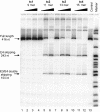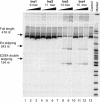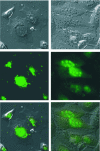Nuclear antisense effects in cyclophilin A pre-mRNA splicing by oligonucleotides: a comparison of tricyclo-DNA with LNA
- PMID: 14726483
- PMCID: PMC373297
- DOI: 10.1093/nar/gkh187
Nuclear antisense effects in cyclophilin A pre-mRNA splicing by oligonucleotides: a comparison of tricyclo-DNA with LNA
Abstract
The nuclear antisense properties of a series of tricyclo (tc)-DNA oligonucleotide 9-15mers, _targeted against the 3' and 5' splice sites of exon 4 of cyclophilin A (CyPA) pre-mRNA, were evaluated in HeLa cells and compared with those of corresponding LNA-oligonucleotides. While the 9mers showed no significant antisense effect, the 11-15mers induced exon 4 skipping and exon 3+4 double skipping to about an equal extent upon lipofectamine mediated transfection in a sequence- and dose-dependent manner, as revealed by a RT-PCR assay. The antisense efficacy of the tc-oligonucleotides was found to be superior to that of the LNA-oligonucleotides in all cases by a factor of at least 4-5. A tc-oligonucleotide 15mer completely abolished CyPA mRNA production at 0.2 microM concentration. The antisense effect was confirmed by western blot analysis which revealed a reduction in CyPA protein to 13% of its normal level. Fluorescence microscopic investigations with a fluorescein labeled tc-15mer revealed a strong propensity for homogeneous nuclear localization of this backbone type after lipofectamine mediated transfection, while the corresponding lna 15mer showed a less clear cellular distribution pattern. Transfection without lipid carrier showed no significant internalization of both tc- and LNA- oligonucleotides. The obtained results confirm the power of tc-DNA for nuclear antisense applications. Moreover, CyPA may become an interesting therapeutic _target due to its important role in the early steps of the viral replication of HIV-1.
Figures








Similar articles
-
_target selection for antisense oligonucleotide induced exon skipping in the dystrophin gene.J Gene Med. 2003 Jun;5(6):518-27. doi: 10.1002/jgm.361. J Gene Med. 2003. PMID: 12797117
-
Towards a therapeutic inhibition of dystrophin exon 23 splicing in mdx mouse muscle induced by antisense oligoribonucleotides (splicomers): _target sequence optimisation using oligonucleotide arrays.J Gene Med. 2004 Oct;6(10):1149-58. doi: 10.1002/jgm.603. J Gene Med. 2004. PMID: 15386737
-
Inhibition of HIV-1 multiplication by antisense U7 snRNAs and siRNAs _targeting cyclophilin A.Nucleic Acids Res. 2004 Jul 14;32(12):3752-9. doi: 10.1093/nar/gkh715. Print 2004. Nucleic Acids Res. 2004. PMID: 15254276 Free PMC article.
-
Making antisense of splicing.Curr Opin Mol Ther. 2005 Oct;7(5):476-82. Curr Opin Mol Ther. 2005. PMID: 16248283 Review.
-
Overview on AON design.Methods Mol Biol. 2012;867:117-29. doi: 10.1007/978-1-61779-767-5_8. Methods Mol Biol. 2012. PMID: 22454058 Review.
Cited by
-
The bench to bedside journey of tricyclo-DNA antisense oligonucleotides for the treatment of Duchenne muscular dystrophy.RSC Med Chem. 2024 Jul 19;15(9):3017-3025. doi: 10.1039/d4md00394b. eCollection 2024 Sep 19. RSC Med Chem. 2024. PMID: 39309360 Review.
-
Evaluation of Chemically Modified Nucleic Acid Analogues for Splice Switching Application.ACS Omega. 2023 Dec 11;8(51):48650-48661. doi: 10.1021/acsomega.3c07618. eCollection 2023 Dec 26. ACS Omega. 2023. PMID: 38162739 Free PMC article. Review.
-
Construction of a tri-chromatic reporter cell line for the rapid and simple screening of splice-switching oligonucleotides _targeting DMD exon 51 using high content screening.PLoS One. 2018 May 16;13(5):e0197373. doi: 10.1371/journal.pone.0197373. eCollection 2018. PLoS One. 2018. PMID: 29768479 Free PMC article.
-
The Use of Tricyclo-DNA Oligomers for the Treatment of Genetic Disorders.Biomedicines. 2017 Dec 22;6(1):2. doi: 10.3390/biomedicines6010002. Biomedicines. 2017. PMID: 29271929 Free PMC article. Review.
-
Efficacy and Safety Profile of Tricyclo-DNA Antisense Oligonucleotides in Duchenne Muscular Dystrophy Mouse Model.Mol Ther Nucleic Acids. 2017 Sep 15;8:144-157. doi: 10.1016/j.omtn.2017.06.013. Epub 2017 Jun 22. Mol Ther Nucleic Acids. 2017. PMID: 28918017 Free PMC article.
References
-
- Kurreck J. (2003) Antisense technologies. Improvement through novel chemical modifications. Eur. J. Biochem., 270, 1628–1644. - PubMed
-
- Friedman K.J., Kole,J., Cohn,J.A., Knowles,M.R., Silverman,L.M. and Kole,R. (1999) Correction of aberrant splicing of the cystic fibrosis transmembrane conductance regulator (CFTR) gene by antisense oligonucleotides. J. Biol. Chem., 274, 36193–36199. - PubMed
-
- Karras J.G., McKay,R.A., Dean,N.M. and Monia,B.P. (2000) Deletion of individual exons and induction of soluble murine interleukin-5 receptor-alpha chain expression through antisense oligonucleotide-mediated redirection of pre-mRNA splicing. Mol. Pharmacol., 58, 380–387. - PubMed
-
- Giles R.V., Spiller,D.G., Clark,R.E. and Tidd,D.M. (1999) Antisense morpholino oligonucleotide analog induces missplicing of C-myc mRNA. Antisense Nucleic Acid Drug Dev., 9, 213–220. - PubMed
Publication types
MeSH terms
Substances
LinkOut - more resources
Full Text Sources
Other Literature Sources

